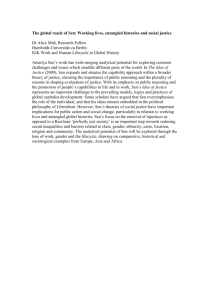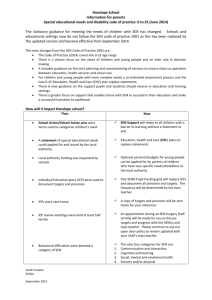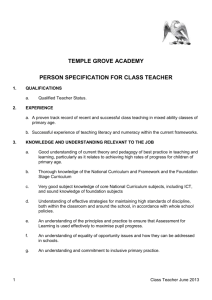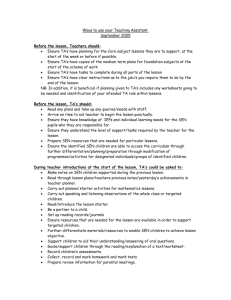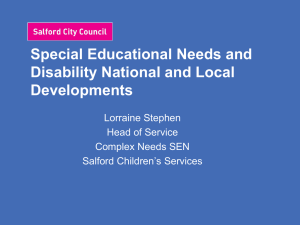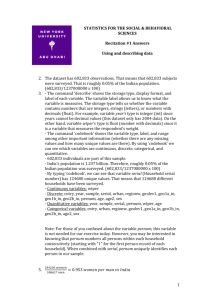The Capability Approach: Its Development, Critiques and Recent
advertisement
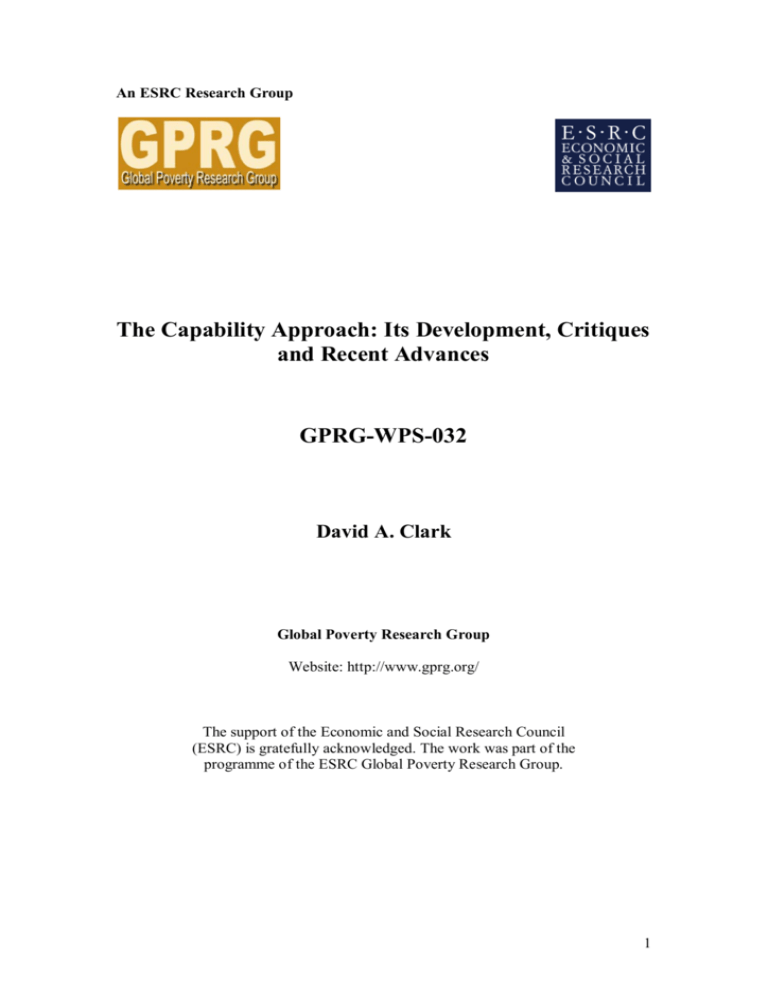
An ESRC Research Group The Capability Approach: Its Development, Critiques and Recent Advances GPRG-WPS-032 David A. Clark Global Poverty Research Group Website: http://www.gprg.org/ The support of the Economic and Social Research Council (ESRC) is gratefully acknowledged. The work was part of the programme of the ESRC Global Poverty Research Group. 1 The Capability Approach: Its Development, Critiques and Recent Advances By David A. Clark* Over the last decade Amartya Sen’s Capability Approach (CA) has emerged as the leading alternative to standard economic frameworks for thinking about poverty, inequality and human development generally. In countless articles and several books that tackle a range of economic, social and ethical questions (beginning with the Tanner Lecture ‘Equality of What?’ delivered at Stanford University in 1979), Professor Sen has developed, refined and defended a framework that is directly concerned with human capability and freedom (e.g. Sen, 1980; 1984; 1985; 1987; 1992; 1999). From the outset Sen acknowledged strong connections with Adam Smith’s (1776) analysis of ‘necessities’ and living conditions and Karl Marx’s (1844) concern with human freedom and emancipation. Later Sen (1993, p.46) recognised that ‘the most powerful conceptual connections’ (which he initially failed to appreciate) relate to Aristotle’s theory of ‘political distribution’ and his analysis of eudaimonia – ‘human flourishing’ (see Nussbaum, 1988; 1990). While the roots of the CA can be traced back to Aristotle, Classical Political Economy and Marx, it is possible to identify more recent links. For example, Sen often notes that Rawls’s Theory of Justice (1971) and his emphasis on ‘self-respect’ and access to primary goods has ‘deeply influenced’ the CA (Sen, 1992, p.8). Another connection, which is not really discussed, relates to Isaiah Berlin’s (1958) classic essay ‘Two Concepts of Liberty’, which mounts a fierce attack on the positive concepts of freedom that inspired Sen (but see Sen, 1999, p.349, n.1 for a tribute to Berlin). Sen also takes the trouble to compare and contrast the CA with some close rivals, which concentrate on entitlements, the priority of liberty, human rights and human capital (Sen, 1984; 1985a; 1997; 1999; 2005). In doing so he generally shows that each approach has something to offer, but only the CA can address all relevant concerns. The CA, however, probably has the most in common with the Basic Needs Approach (BNA) to development pioneered by Paul Streeten et al (1981) and Frances Stewart (1985), amongst others (see Stewart, forthcoming). In an early paper entitled ‘Goods and People’, Sen tries to distinguish between the CA and BNA through a fivefold critique of the latter (Sen, 1984, pp.513-5). Some of Sen’s criticisms, however, appear to misrepresent the BNA (Alkire, 2002, pp.166-170). In particular the argument that the BNA lapses into a form of ‘commodity fetishism’ has been challenged. While this is a valid criticism of the original formulation of basic needs (e.g. ILO, 1976), the architects of the ‘new basic needs’ approach have reiterated that ‘[t]he concept of basic needs as we understood it, was not (as is sometimes thought) centred on the possession of commodities. Instead, it was concerned with providing all human * Global Poverty Research Group, Institute for Development Policy and Management, University of Manchester, UK. This paper is forthcoming under the title ‘Capability Approach’ in Clark, D. A. (ed.) (2006), The Elgar Companion to Development Studies, Cheltenham: Edward Elgar. The author would like to thank Jocelyn De Jong, Geoff Harcourt, David Hulme, Gay Meeks, Stephen Porter and Mozaffar Qizilbash for helpful comments and suggestions. The usual disclaimers apply. © David Clark November 2005. Email: David_A_Clark@hotmail.com 2 beings, but particularly the poor and deprived, with the opportunities for a full life’ (Streeten in Haq, 1995, p.ix; Streeten et al., 1981, p.21). Nevertheless, it is now widely recognised that the CA manages to bring together many of the concerns of basic needs theorists (originally expressed in a rather ad-hoc manner) into a single coherent philosophical framework (Streeten, 1984; Stewart and Deneulin, 2002; Alkire, 2002). Moreover, unlike the BNA, the CA extends beyond the analysis of poverty and deprivation and often concerns itself with well-being generally. Finally, Alkire (2002, p.170) observes that ‘the single most important function of the CA is to make explicit some implicit assumptions in the BNA about the value of choice and participation (and the disvalue of coercion)’. Conceptual Foundations The conceptual foundations of the CA can be found in Sen’s critiques of traditional welfare economics, which typically conflate well-being with either opulence (income, commodity command) or utility (happiness, desire fulfilment) (see Crocker, 1992 and Clark, 2002, pp.29-34 for more extensive discussions of these critiques). Sen distinguishes between commodities, human functioning/ capability and utility as follows: Commodity ! Capability (to function) ! Function(ing) ! Utility (e.g. happiness) He begins by considering income or commodity command. Like Adam Smith, Sen (1983) emphasises that economic growth and the expansion of goods and services are necessary for human development. However, like Aristotle, he reiterates the familiar argument that ‘…wealth is evidently not the good we are seeking; for it is merely useful and for the sake of something else’ (Sen, 1990, p.44). In judging the quality of life we should consider what people are able to achieve. Sen then observes that different people and societies typically differ in their capacity to convert income and commodities into valuable achievements. For example, a disabled person may require extra resources (wheel chairs, ramps, lifts, etc) to achieve the same things (moving around) as an able bodied person. Moreover, a child typically has very different nutritional requirements from a manual labourer, pregnant woman or someone with a parasitic disease. Similarly, the commodity requirements for more complex social achievements (such as ‘appearing in public without shame’ or ‘entertaining family and friends’) typically depend on ‘cultural’ factors such as social convention and custom or status and class, inter alia (Sen 1985, pp.25-26; 1999, pp.70-71). In comparing the well-being of different people, not enough information is provided by looking only at the commodities each can successfully command. Instead we must consider how well people are able to function with the goods and services at their disposal. Sen also challenges the welfare or utility approach, which concentrates on happiness, pleasure and desire-fulfilment. (The choice based approach is regarded as a ‘nonstarter’ as people do not always choose in accordance with their own personal interests but often wish to consider wider concerns (Sen, 1985, pp.18-20)). Following Rawls he recognises that utility does not distinguish between different sources of pleasure and pain or different kinds of desires (Sen, 1984, p.308; Rawls, 1971, pp.3031). In particular, utility fails to discriminate against ‘offensive tastes’ (such as taking 3 pleasure in another person’s misery), although this approach could be modified to deal with this criticism (Cohen, 1993, p.31). More fundamentally, Sen points out that there is more to life than achieving utility. ‘Happiness or desire fulfilment represents only one aspect of human existence’ (Sen, 1984, p.512). While it is important to take note of utility, there are many other things of intrinsic value (notably rights and positive freedoms) that are neglected by the welfare approach (Sen, 1987, p.8; 1992, p.54; 1999, p.62). This might not be a serious problem in cases where utility levels reflect personal circumstances and deprivations. However, Sen (1999, p.62) indicates that ‘utility can be easily swayed by mental conditioning or adaptive expectations’. Among other things he cites evidence from a post famine health survey in India that suggests significant disparities between the externally observed health of widows and their own subjective impressions of their physical state (Sen, 1985, pp.82-3). These considerations lead to the conclusion that neither opulence (income, commodity command) nor utility (happiness, desire fulfilment) constitute or adequately represent human well-being and deprivation. Instead what is required is a more direct approach that focuses on human function(ing)s and the capability to achieve valuable function(ing)s. Sen (1985; 1993) makes the following distinctions: • • • • Functioning – ‘A functioning is an achievement of a person: what she or he manages to do or be. It reflects, as it were, a part of the “state” of that person’ (Sen, 1985, p.10). Achieving a functioning (e.g. being adequately nourished) with a given bundle of commodities (e.g. bread or rice) depends on a range of personal and social factors (e.g. metabolic rates, body size, age, gender, activity levels, health, access to medical services, nutritional knowledge and education, climatic conditions, etc). A functioning therefore refers to the use a person makes of the commodities at his or her command. Capability – A capability reflects a person’s ability to achieve a given functioning (‘doing’ or ‘being’) (Saith, 2001, p.8). For example, a person may have the ability to avoid hunger, but may choose to fast or go on hunger strike instead. (Note that Sen typically uses the term capability in a much broader and more general sense to refer to capabilities in plural or the actual ability to function in different ways – see below). Functioning n-tuple – A functioning n-tuple (or vector) describes the combination of ‘doings’ and ‘beings’ that constitute the state of a person’s life. The functioning n-tuple is given by the utilisation (through a personal utilisation function) of the available commodity bundle. Each functioning ntuple represents a possible life-style. Capability Set – The capability set describes the set of attainable functioning n-tuples or vectors a person can achieve. It is likely that a person will be able to choose between different commodity bundles and utilisations. The capability set is obtained by applying all feasible utilisations to all attainable commodity bundles (Sen, 1985; Saith, 2001). Sen (1985; 1992; 1999) emphasises that capabilities reflect a person’s real opportunities or positive freedom of choice between possible life-styles. Sen (1985) provides a formal treatment of this framework. However, most discussions and applications of the CA dispense with mathematical formalisation, which is not strictly necessary for most purposes. In practice Sen uses the term ‘capability’ in a broader sense than above to refer to ‘the alternative combination of functionings the 4 person can achieve, from which he or she can choose one collection’ (Sen, 1993, p.31; see also Sen, 1992, p.40; 2005, p.153). So instead of describing specific abilities (such as being able to avoid hunger), the notion of ‘capability’ is effectively used a synonym for the capability set (see also Qizilbash, 2005 on different uses of the term ‘capability’ in Sen’s work). Sen argues that capability or freedom has intrinsic value and should be regarded as ‘the primary informational base’ (Sen, 1993, pp.38-9). One of the chief strengths of Sen’s framework is that it is flexible and exhibits a considerable degree of internal pluralism, which allows researchers to develop and apply it in many different ways (Alkire, 2002, pp.8-11, 28-30). Three points are noteworthy. First, Sen does not subscribe to a fixed or definitive list of capabilities. Instead he argues that the selection and weighting of capabilities depend on personal value judgements (which are partly influenced by the nature and purpose of the evaluative exercise). While Sen often provides examples of intrinsically valuable capabilities – such as being able to ‘live long, escape avoidable morbidity, be well nourished, be able to read, write and communicate, take part in literary and scientific pursuits and so forth’ (Sen, 1984, p.497; see also Clark, 2002, table 3.1) – he refuses to endorse a unique list of capabilities as ‘objectively correct’ for practical and strategic reasons (Sen, 1993, p.47; Clark, 2002, p.54; Qizilbash, 2002). Second, Sen indicates that the CA can be used to assess individual advantage in a range of different spaces. For example, the assessment of poverty might involve concentrating on a relatively small sub-set of basic capabilities. Evaluating well-being or human development on the other hand seems to require a much longer and more diverse list of capabilities (see for example Sen, 1993, pp. 31-2, 40-42). The focus of the CA can be broadened further to include ‘agency’, which recognises that individuals often have values and goals (such as preserving the environment, purchasing free trade products or opposing injustice, tyranny and oppression) that transcend and sometimes even conflict with personal well-being (see Sen, 1985; 1985a; 1992, ch.4). The CA has also been adjusted to focus on inequality, social justice, living standards and rights and duties (among other things). Finally, Sen (1999, p.77) recognises that the CA is not sufficient for all evaluative purposes. By itself the CA does not provide a complete theory of justice or development (see Sen, 1983; 1988; 1992, p.77; 2005). We need to take note of other principles such as personal liberty, economic growth and efficiency. Sen’s CA has also been praised for broadening the informational base of evaluation, refocusing on people as ends in themselves (rather than treating them merely as means to economic activity), recognising human heterogeneity and diversity (through differences in personal conversion functions), drawing attention to group disparities (such as those based on gender, race, class, caste or age), embracing human agency and participation (by emphasising the role of practical reason, deliberative democracy and public action in forging goals, making choices and influencing policy), and acknowledging that different people, cultures and societies may have different values and aspirations. The CA has been criticised from several different angles. In many cases key strengths are re-construed as potential weaknesses by critics (notable examples include contrasting viewpoints about the merits of incompleteness). The most well known set of criticisms relate to the issue of ‘how far Sen’s framework is operational’ (Sugden, 1993, p.1953). The first of these criticisms concerns the identification of valuable capabilities. Several commentators have criticised Sen for failing to supplement his 5 framework with a coherent list of important capabilities (e.g. Williams, 1987, p.96; Nussbaum, 1988, p.176; Qizilbash, 1998, p.54). Others have argued that Sen goes too far in terms of insisting that certain capabilities simply are valuable (Sen, 1992, p.40), ‘given the extent of disagreement among reasonable people about the nature of a good life’ (Sugden, 1993, pp.1952-3). This line of attack, however, misrepresents Sen’s actual position and conflicts with the available evidence on value formation (see the following section). A second line of criticism casts doubt on the usefulness of the CA for making inter-personal comparisons of well-being in the presence of potential disagreements about the valuation of capabilities including the relative weights to be assigned to these capabilities (e.g. Beitz, 1986). Sen, however, is remarkably optimistic about achieving agreement about evaluations: he suggests that the intersections of different people’s rankings are ‘typically quite large’ (Sen, 1985, pp.53-6). He has also proposed a range of methods including ‘dominance ranking’ and the ‘intersection approach’ for extending incomplete orderings (see Sen, 1985; 1993; Saith, 2001). Finally, the informational requirements of the CA can be extremely high (see Alkire, 2002, pp.181-93; Sen, 1994). Evaluating social states typically depends on acquiring data on multiple functionings. In some cases, however, the relevant social indicators simply aren’t available. Moving from functioning to capability complicates the exercise drastically as additional information is required on counterfactual choices (which cannot be observed) as well as actual choices. Despite these operational difficulties many credible innovative attempts have been made to measure well-being in the functioning and capability space (see the final section below). Completing the Capability Approach Attempts to complete the CA often focus on augmenting Sen’s framework with a theory of the good to guide moral judgements. Many different ethics of human wellbeing and need have emerged in development studies, social science and philosophy (see Alkire, 2002, ch.2; Clark, 2002, ch.3; Saith, 2001). Alkire and Black (1997), Alkire (2002, ch.4), Clark (2002, ch.4; 2003), Desai (1995), Nussbaum (1990; 1995; 2000; 2003) and Robeyns (2003) have all generated lists of human capabilities in an effort to apply Sen’s framework. The methodologies employed vary in style and sophistication and range from the ad-hoc selection of capabilities by ‘experts’ to more complex rules and procedures for identifying capabilities as well as participatory approaches that listen to the voices of the poor. The most well-known and influential attempt to complete the CA can be found in the writings of the feminist philosopher, Martha Nussbaum. Nussbaum’s version of the CA differs from Sen’s in several respects (see Nussbaum, 2000, pp.11-15; 2003, pp.43-4; Sen, 1993). The most notable difference is that Nussbaum draws heavily on Aristotle in an effort to develop a definite list of ‘central human capabilities’ (see Nussbaum, 1990; 1995; 2000). The headings of the latest version of this list (which has basically not changed much over the years) are: (1) Life; (2) Bodily health; (3) Bodily integrity; (4) Senses, imagination and thought; (5) Emotions; (6) Practical reason; (7) Affiliation; (8) Other species; (9) Play; and (10) Political and material control over one’s environment (Nussbaum, 2000, pp.72-5; 2003, pp.41-2; 2005a, pp.41-2). According to Nussbaum this list ‘isolates those human capabilities that can be convincingly argued to be of central importance in any human life, whatever else 6 the person pursues or chooses’ (Nussbaum, 2000, p.74). It therefore provides basic political principles that should be embodied in constitutional guarantees, human rights legislation and development policy (Nussbuam, 1995, p.87; 2000, p.74-5). While Nussbaum’s general approach has evolved since the appearance of her first list in 1990, it is possible to identify a number of tensions and contradictions in her writings – particularly between her proposed methodology and style of essentialism (see Clark, 2002, ch.3). The most serious of these tensions relates to the way in which her list is compiled. Nussbaum has always maintained that her list is subject to ongoing revision and should emerge through some sort of intercultural ethical inquiry. In particular she encourages us to encounter and learn from other cultures and societies in an effort to move towards a shared account of the core human capabilities (Nussbaum 1995, p.74). This approach involves ‘internal criticism’ of local values and practices by appealing to external standards (see Nussbaum and Sen, 1989). In theory this approach is promising, although in practice there are times when one might want to challenge the motives for encouraging ‘value rejection’ in poor countries. In the end it seems that ‘we must accept any genuinely rational assessment of [local] values that local people see fit to provide’ (Clark, 2002, p.78). In other words it is not so much the method itself that is fraught but its potential for abuse. Nussbaum claims that recent lists represent ‘years of cross cultural discussion’ (Nussbaum, 2000, p.76). Comparing the most recent lists with the original shows that the core categories have not changed (Nussbaum, 1990 v. 2003 and 2005a). Some descriptive content has been added and some parts of the list have been reorganised. No categories, however, have been added or deleted. Moreover, revisiting the original list indicates that nearly all Nussbaum’s capabilities are actually derived from the writings of Aristotle (Nussbaum, 1990, notes 52-65; Clark, 2002, p.78). Some commentators have suggested that it is paternalistic for a middle class North American philosopher to determine capabilities for other cultures and societies and have advocated the deployment of more participatory approaches (Stewart, 2001, p.1192; Clark, 2002). While Nussbaum’s book Women and Human Development (2000) draws on two brief field trips to India, her case studies ‘may be rather thin in both number (two) and depth (perhaps from single meetings reliant on interpreters), for Nussbaum’s ambitious project’ (Gasper, 2001, p.4; see also Gargarella, 2001). In the end Nussbaum’s list should be viewed ‘not as a headcount of present-day opinions, but as a hypothesis about what would over time become an acceptable starting points for discussions in each society, as a rational interpretation, implication and evolution of their values’ (Gasper, 2004, p.187). Meanwhile Sen (1999; 2004; 2005) has advocated a more direct approach for eliciting relevant information about the formation of human values, which emphasises the constructive role of democracy and the importance of public participation and discussion: The problem is not with listing important capabilities, but with insisting on one predetermined canonical list of capabilities, chosen by theorists without any general social discussion or public reasoning. To have such a fixed list, emanating entirely from pure theory, is to deny the possibility of fruitful public participation on what should be included and why… public discussion and reasoning can lead to a better understanding of the role, reach and significance of particular capabilities… (Sen, 2004, pp.77, 81). 7 In the event of a conflict between values or traditions, Sen argues ‘it is the people directly involved who must have the opportunity to participate in deciding what should be chosen’, not local elites (political or religious) or cultural ‘experts’ (domestic or foreign) (Sen, 1999, pp.31-2). Sabina Alkire (2002, esp. ch.4) has developed a promising methodology for applying Sen’s approach at the micro level, which draws on participatory tools and techniques (pioneered by Robert Chambers and associates) in an effort to answer the question: ‘How do we identify valuable capabilities?’ (p.v). However, Alkire does not systematically identify valuable capabilities through fieldwork herself (except insofar as they arose in her three ‘impact assessment’ case studies of development projects in Pakistan). Nor does she consider the implications of such an exercise for the many different conceptions of poverty and well-being described in her book. This brings us to David Clark’s plea for ‘empirical philosophy’ (Clark, 2002, p.5; 2002a), and his attempt to confront abstract concepts of human well-being and development with the values and experiences of the poor (see Clark, 2000; 2002; 2003; see also Okin, 2003). Clark developed and applied a methodology and survey instrument for investigating perceptions of well-being among the urban and rural poor in South Africa (Clark, 2002, ch.4). He found that the most frequently mentioned aspects of a good life in South Africa were jobs, housing, education, income, family and friends, religion, health, food, good clothes, recreations and relaxation, safety and economic security, inter alia (a result that is not inconsistent with the findings of most participatory poverty assessments). Respondents were asked to elaborate on the reasons for valuing these items, before being asked to evaluate an expert defined list of capabilities (see Clark, 2002, pp.108-36). The most significant finding to emerge from this study is that most people appear to share a common vision of the good, which is not fundamentally at odds with the capabilities advocated by scholars like Nussbaum and Sen. Most theories of well-being and need, however, ought to say more about (1) the practical side of survival and development in poor countries, (2) the psychology of human well-being, i.e. mental functioning; and (3) some of the ‘better things’ in life such as recreation (Clark, 2002, pp.136-44). Of course the CA may turn out to be just as susceptible as utility to the problem of adaptive preferences and cultural indoctrination (Nussbaum, 1988, p.175; Sumner, 1996, pp.60-68). This is a very real concern. The available evidence from South Africa, however, suggests that adaptation and indoctrination have not generally distorted response to questions about the selection and value of capabilities (Clark, 2002, pp.103, 129-31; Clark and Qizilbash, 2002; 2005; Qizilbash and Clark, 2005). Others have expressed concern that Sen’s notion of deliberative democracy is too idealistic, as it neglects political power and may lead to decisions that undermine capabilities or worsen the position of the poor (Stewart and Deneulin, 2002, pp.63-4). Finally Qizilbash (2002) has appealed to advocates of the CA and related perspectives to unite against ‘common foes’ instead of dwelling upon relatively minor disagreements concerning the components of well-being. Clarification and Enlargement 8 Several attempts have been made to clarify and enlarge on other aspects of Sen’s original framework. Four inter-related areas of work are briefly considered. First, several attempts have been made to clarify the concept of capability – particularly in relation to functioning (see Clark, 2002, ch.2, appendix). Sen (1992, p.41) refines the notion of capability to include genuine choice with substantial options. The goodness of the capability set should be judged in terms of the quality as well as the quantity of available opportunities (Sen, 1985, p.69; 1993, p.34-5; Crocker, 1998). There may also be a case for evaluating capability sets in terms of the diversity of options. Sen (1992, Ch. 9.9) also emphasises the importance of ‘responsible choice’. He accepts that it might be better to concentrate on outcomes (functionings achieved) if intelligent choice is complicated by uncertainty (see also Kanbur, 1987) or social conditioning robs a person of the courage to live in a particular way. Some capabilities (e.g. being able to live long), however, do not appear to involve a very meaningful notion of choice (Williams, 1987, pp.96-8; Crocker, 1995, pp.163-4), while others (e.g. being able to avoid cholera or malaria) depend more on public action and social policy than individual choice (Sen, 1992, pp.64-9). Furthermore, choosing to realise some capabilities may involve huge opportunity costs, which implies we should focus on ‘sets of co-realisable capabilities’ (Williams, 1987, pp.98-100; Sen, 1987, p.109). Paul Streeten (2000, p.159) has suggested that it may be ‘better to separate freedom of choice, and to look at poverty and deprivation in terms of observable achievements’. More radical critics have shunned the value of freedom as choice (Gasper, 2002, esp. pp.456-8). A second strand of research criticises Sen’s CA for underplaying the importance of negative freedom vis-à-vis positive freedom (Qizilbash, 1996, p.147; Carter, 1996). In some respects negative freedom seems to feature more prominently in versions of the CA that distinguish internal capabilities from the external conditions required to achieve these capabilities (see, for example, the discussion of Nussbaum’s approach in the next paragraph). Sen, however, does acknowledge ‘the special significance of negative freedom’ for the CA (Sen, 1992, p.87). He argues that capability failure can stem from the violation of personal rights as well as the absence of positive freedoms (Sen, 1985a, lecture 3). Moreover, in contrast to some capability theorists (who tend to shun personal liberty, e.g. Nussbaum, 2005b, pp.176-7), Sen argues that negative freedom has intrinsic as well as instrumental significance (Sen, 1985a, pp.218-21). A third line of research is concerned with notions of agency and personhood. Several commentators have argued for a sharper distinction between internal powers and skills and actual opportunities or outcomes (Nussbaum, 1988; Crocker, 1995; Qizilbash, 1996; Gasper, 1997; 2002). The precise distinctions proposed vary slightly and have evolved. A notable example is Nussbaum’s (2000, pp.84-6) distinction between basic, internal and combined capabilities. Basic capabilities reflect ‘the innate equipment of individuals that is necessary for developing more advanced capabilities, and a ground for moral concern’. Many of these latent powers and skills are transformed into internal capabilities (with the support of the surrounding environment) over the course of a normal life and become ‘developed states of the person’ or ‘mature states of readiness’, which ‘are, so far as the person herself is concerned, sufficient conditions for the exercise of requisite functions’. Finally, combined capabilities ‘may be defined as internal capabilities combined with suitable external conditions for the exercise of the function’ (pp.84-5, original emphasis). 9 Gasper (2002, p.447) has criticised Sen for failing to modify his terminology in line with these distinctions. He has also argued for a richer conception of human personality, which incorporates the variety of values and motives that influence human action (Gasper, 2002; 2004, p.180). These motivations extend well beyond Sen’s (1977) classic distinction between acts based on ‘sympathy’ (feelings for other people) and ‘commitment’ (goals beyond personal well-being). The fourth and final area of research concerns itself with means and ends. Some commentators have suggested that Sen pays insufficient attention to ‘the means of freedom’ (Qizilbash, 1996), while others have emphasised the links between human capital and human capability (Streeten, 1994; 2000; Haq, 1995; Sen, 1997; 1999; Bebbington, 1999). While both these approaches ‘put humanity at the centre of attention… the narrower view of the human capital approach fits into the more inclusive perspective of human capability’ which takes note of the direct relevance of human capabilities for well-being and their indirect role through facilitating social change and promoting economic activity (Sen, 1997, pp.1959-60; 1999, pp.292-7). The latest version of Sen’s CA explicitly recognises five broad categories of instrumental freedoms (political freedom, economic facilities, social opportunities, transparency guarantees and protective security), which contribute to the expansion of human capabilities (Sen, 1999, esp. ch.2). The empirical links and interconnections between different capabilities and freedoms have also been examined (Sen, 1999; Clark, 2002; 2005). One promising approach, which has not been fully worked out, involves developing a matrix of means and ends to help think through the many complex interconnections between different capabilities together with the policy implications (May, 2000, pp.8-9). Public Policy and Action As we have seen the CA suggests that the overriding objective of development is the expansion of human capabilities rather than economic growth. While growth may be necessary for development, it is not always sufficient. In broad terms it is possible to distinguish between ‘growth mediated’ and ‘support led’ development (Dreze and Sen, 1989; Sen, 1999, ch.2). The former operates through rapid and broad based economic growth, which facilitates the expansion of basic capabilities through higher employment, improved prosperity and better social services. The latter works primarily through proficient welfare programmes that support health, education and social security. Public action also plays an important role in supporting capabilities directly and providing political pressure for state intervention in times of crisis and hardship. At the micro level policy action might focus on selecting beneficiaries (according to functioning poverty) for public works programmes, welfare payments or microfinance projects, inter alia (e.g. Dreze and Sen, 1989; Alkire, 2002). Such projects should take note of ‘adequate income’, which considers the amount of money each person needs to achieve minimal functioning (Sen, 1992, ch.7; 1993, pp.41-2). The problem with this kind of approach is that it is difficult to identify people with relatively efficient conversion functions in advance. Such people need less money than others to avoid capability failure, but have powerful incentives to conceal their advantage in order to maximise personal income and well-being. This means that development 10 projects based on adequate income will alleviate functioning poverty, but at a higher cost than is necessary and with undesirable distributive consequences (Balestrino, 1994, pp.400-401). Other small-scale development projects such as community literacy programmes and health initiatives tackle capability failure directly. The CA also provides a strong justification for the promotion of interpersonal equity in the space of basic capabilities. More work is required to bring out the policy implications of the CA. To this end the Human Development and Capability Association (HDCA) is currently working on a series of policy briefs (http://www.hd-ca.org). Some commentators have suggested that the CA requires a complementary theory of obligations and duties (Gasper, 2004, p.178); others have pointed to possible tension between the goal of basic capability equality on the one hand and the objective of (overall) capability expansion on the other (Alkire, 2002, pp.177-8). Some thinkers have argued that democratic processes may not be sufficient to bring about the necessary changes or have called for collective action to influence public policy (Stewart and Deneulin, 2002, pp.69-70; Fukuda-Parr, 2003, p.309). More controversially, some critics have taken issue with the regularity and selectiveness of the examples Sen uses to justify policy insights or have challenged his reading of the empirical evidence (Nolan and Sender, 1992; Corbridge, 2002). Applications and Guide to Further Reading Attempts to apply the CA have mushroomed in recent years. Among other things the CA has been used to investigate poverty, inequality, well-being, social justice, gender, social exclusion, health, disability, child poverty and identity. It has also been related to human needs, human rights and human security as well as development more broadly. Most empirical studies fall into at least one of three categories. First, there have been numerous attempts to apply the CA to the measurement of poverty and well-being (e.g. Balestrino, 1996; Chiappero Martinetti, 1994; 1996; 2000; Clark and Qizilbash, 2002; 2005; Klasen, 1997; 2000; Majumdar and Subramanian, 2001; Qizilbash and Clark, 2005; Sen, 1992; 1999). The most well known measure is the human development index, which covers income (opportunities), life expectancy, and education (see Sen, forthcoming). While most applications focus on functioning, some studies have tried to capture capabilities in terms of freedom to choose (e.g. Schokkaert and Van Ootegem, 1990) or human talents and skills (e.g. Jasek-Rysdahl, 2001). Second, several studies have investigated the links between income (or expenditure) and various capabilities (e.g. Sen, 1985; 1999; Balestrino, 1996; Ruggeri-Laderchi, 1997; Klasen, 2000). Many of these studies provide empirical support for the CA by suggesting that income and capabilities do not always go together. Finally, a third strand of work highlights group disparities by pointing to gross inequalities in terms of life expectancy, nutrition and literacy, etc, along the lines of gender, race, class, caste and age (e.g. Sen, 1985; 1999; Majumdar and Subramanian, 2001). Sen (1990; 1993), Alkire (2002) and Saith (2001) provide excellent introductions to the CA. In particular several edited books consider a range of different issues relating to the CA (Sen, 1987; Nussbaum and Sen, 1993; Nussbaum and Glover, 1995; Comim, Qizilbash and Alkire, forthcoming). There have also been several major 11 international conferences on the CA since 2001, which have generated a lot of new research – especially by younger scholars (http://cfs.unipv.it/sen/index.html). A growing number of special journal issues have also been devoted to the CA. These include Giornale Delgi Economist e Annali di Economia (Vol.53, 1994), Notizie di Politeia (Vol.12, Nos.43-44, 1996), Journal of International Development (Vol.9, No.2, 1997; and Vol.12, No.7, 2000), Review of Political Economy (Vol.14, No.4, 2002), Feminist Economics, (Vol.9, Nos.2-3, 2003), Social Science and Medicine (Vol.60, No.2, 2005), Journal of Human Development (Vol.6, No.2, 2005), Social Indicators Research (Vol.74, No.1, 2005) and Social Science Research (forthcoming). The shear number, quality and diversity of practical applications that have emerged in recent years arguably lays to rest any remaining concerns about the possibility of making the CA operational. References Alkire, S. (2002), Valuing Freedoms: Sen’s Capability Approach and Poverty Reduction, Oxford: Oxford University Press. Alkire, S. and Black, R. (1997), ‘A Practical Reasoning Theory of Development Ethics: Furthering the Capabilities Approach’, Journal of International Development, 9(2), 263–79. Balestrino, (1994), ‘Poverty and Functioning: Issues in Measurement and Public Action’, Giornale Delgi Economist e Annali di Economia, 53, 389-406. Balestrino, A., (1996), ‘A Note on Functioning Poverty in Affluent Societies’, Notizie di Politeia, 12, 97-105. Bebbington, A. (1999), ‘Capitals and Capabilities: A Framework for Analyzing Peasant Viability, Rural Livelihoods and Poverty’, World Development, 27(12), 2021-44. Beitz, C. R., (1986), ‘Amartya Sen’s Resources, Values and Development’, Economics and Philosophy, 2(2), pp.282-91. Berlin, Isaiah (1958), ‘Two Concepts of Liberty’, reprinted in Isaiah Berlin (1982), Four Essays on Liberty, Oxford: Oxford University Press. Carter, I. (1996), ‘The Concept of Freedom in the Work of Amartya Sen: An Alternative Analysis Consistent with Freedom’s Independent Value’, Notizie di Politeia, 12(43/44), 7-22. Chiappero Martinetti, E., (1994), ‘A New Approach to the Evaluation of Well-being and Poverty by Fuzzy Set Theory’, Giornale Degli Economisti e Annali di Economia, 53, 367-88. Chiappero Martinetti, E., (1996), ‘Standard of Living Evaluation Based on Sen’s Approach: Some Methodological Suggestions’, Notizie di Politeia, 12(43/44), 37-53. 12 Chiappero Martinetti, E., (2000), ‘A Multi-dimensional Assessment of Well-being Based on Sen’s Functioning Approach’, Rivista Internationale di Scienzie Sociali, 108, pp. 207-31. Clark, D. A. (2000), ‘Concepts and Perceptions of Development: Some Evidence from the Western Cape’, SALDRU Working Paper 88, University of Cape Town. Clark, D. A. (2002), Visions of Development: A Study of Human Values, Cheltenham: Edward Elgar. Clark, D. A. (2002a), ‘Development Ethics: A Research Agenda’, International Journal of Social Economics, 29(11), 830-848. Clark, D. A. (2003), ‘Concepts and Perceptions of Human Well-Being: Some Evidence from South Africa, Oxford Development Studies, 31(2), 173-196. Clark, D. A. (2005), ‘Sen’s Capability Approach and the Many Spaces of Human Well-Being’, Journal of Development Studies, 41(8), 1339-1368. Clark, D. A. and Qizilbash M. (2002), ‘Core Poverty and Extreme Vulnerability in South Africa’, Discussion Paper No. 2002-3, School of Economics, University of East Anglia, UK. Revised version: http://www.geocities.com/poverty_in_southafrica Clark, D. A. and Qizilbash, M. (2005), ‘Core Poverty, Basic Capabilities and Vagueness: An Application to the South African Context’, GPRG Working Paper 26, Universities of Manchester and Oxford, UK. Available online at http://www.gprg.org/pubs/workingpapers/pdfs/gprg-wps-026.pdf Cohen, G. A. (1993), ‘Equality of What? On Welfare, Goods and Capabilities’, in Martha C. Nussbaum and Amartya K. Sen (eds), The Quality of Life, Oxford: Clarendon Press, pp. 9–29. Comim, F., Qizilbash, M. and Alkire, S. (eds) (forthcoming), The Capability Approach: Concepts, Measures and Applications, Cambridge: Cambridge University Press. Corbridge, S. (2002), ‘Development As Freedom: The Spaces of Amartya Sen’, Progress in Development Studies, 2(3), 183-217. Crocker, D. A. (1992), ‘Functioning and Capabilities: The Foundation of Sen’s and Nussbaum’s Development Ethic’, Political Theory, 20(4), 584–612. Crocker, David A. (1995), ‘Functioning and Capability: The Foundation of Sen’s and Nussbaum’s Development Ethic, part II’, in Martha C. Nussbaum and Jonathan Glover (eds), Women, Culture and Development, Oxford: Clarendon Press, pp. 153–98. 13 Crocker David A., (1998), ‘Consumption, Well-Being and Capability’ in David A. Crocker and Toby Linden (eds), Ethics of Consumption: The Good Life, Justice and Global Stewardship, New York: Rowman and Littlefield Publishers, pp.366-90. Desai, Meghnad (1995), ‘Poverty and Capability: Towards An Empirically Implementable Measure’ in Poverty, Famine and Economic Development, Aldershot: Edward Elgar, pp.185-204. Dreze, Jean and Sen, Amartya K. (1989), Hunger and Public Action, Oxford: Clarendon Press. Fukuda-Parr, S. (2003), ‘The Human Development Paradigm: Operationalizing Sen’s Ideas on Capabilities’, Feminist Economics, 9(2-3), 301-317. Garagella, Roberto (2001), ‘Women and Human Development: Review’, IDEA Newsletter, June, Available online at www.carleton.ca/idea/newsletter/reports_062001_2.html Gasper, D. (1997), ‘Sen’s Capability Approach and Nussbaum’s Capabilities Ethic’, Journal of International Development, 9(2), 281–302. Gasper, Des (2001), ‘Women and Human Development: Review’, IDEA Newsletter, June, Available online at www.carleton.ca/idea/newsletter/reports_062001_7.html Gasper, D. (2002), ‘Is Sen’s Capability Approach an Adequate Basis for Considering Human Development?’, Review of Political Economy, 14(4), 435-461. Gasper, Des (2004), The Ethics of Development, Edinburgh: Edinburgh University Press. Haq, Mahbub ul (1995), Reflections on Human Development, Oxford: Oxford University Press. ILO (1976), Employment, Growth and Basic Needs: A One World Problem, Geneva: International Labour Organisation. Jasek-Rysdahl, K. (2001), ‘Applying Sen’s Capability Approach to Neighbourhoods: Using Local Asset Maps to Deepen Our Understanding of Well-Being’, Review of Social Economy, 59(3), 313-29. Kanbur, Ravi (1987), ‘The Standard of Living: Uncertainty, Inequality and Opportunity’, in Geoffrey Hawthorn (ed.), The Standard of Living, Cambridge: Cambridge University Press, pp. 70–93. Klasen, S., (1997), ‘Poverty, inequality and deprivation in South Africa: an analysis of the 1993 SALDRU survey’, Social Indicators Research, 41, 51-94. 14 Klasen, S., (2000), ‘Measuring poverty and deprivation in South Africa’, Review of Income and Wealth, 46(1), 33-58. Majumdar, M. and Subramanian, S. (2001), ‘Capability failure and group disparities: some evidence from India from the 1980s’, Journal of Development Studies, 37(5), 104-140. Marx, Karl (1844), Economic and Philosophic Manuscript (English Translation), London: Lawrence and Wishart, 1977. May, Julian (ed.) (2000), Poverty and Inequality in South Africa: Meeting the Challege, London: Zed Books. Nussbaum, M. C. (1988), ‘Nature, Function and Capability: Aristotle on Political Distribution’, Oxford Studies in Ancient Philosophy, Supl. Vol., 145–84. Nussbaum, Martha C. (1990), ‘Aristotelian Social Democracy’, in Bruce Douglas, Gerald Mara and Henry Richardson (eds), Liberalism and the Good, New York: Routledge, pp. 203–52. Nussbaum, Martha C. (1995), ‘Human Capabilities, Female Human Beings’, in Martha C. Nussbaum and Jonathan Glover (eds), Women, Culture and Development, Oxford: Clarendon Press, pp. 61–104. Nussbaum, Martha C. (2000), Women and Human Development: the Capabilities Approach, Cambridge: Cambridge University Press. Nussbaum, M. C. (2003), ‘Capabilities as Fundamental Entitlement: Sen and Social Justice’, Feminist Economics, 9(2-3), 33-59. Nussbaum, M. C. (2005a), ‘Well-Being, Contracts and Capabilities’ in Lenore Manderson (ed.), Rethinking Well-Being, Perth: API Network, pp.27-44. Nussbaum, M. C. (2005b), ‘Women’s Bodies: Violence, Security, Capabilities’, Journal of Human Development, 6(2), 167-83. Nussbaum, Martha C. and Glover, Jonathan (eds) (1995), Women, Culture and Development, Oxford: Clarendon Press. Nussbaum, Martha C. and Sen, Amartya K. (1989), ‘Internal Criticism and Indian Rationalist Traditions’, in Michael Krausz (ed.) Relativism, Interpretation and Confrontation, South Bend: University of Notre Dame Press, pp. 299–325. Nussbaum, Martha C. and Sen, Amartya K. (eds) (1993), The Quality of Life, Oxford: Clarendon Press. Nolan, P. and Sender, J. (1992), ‘Death Rates, Life Expectancy and China’s Economic Reforms: A Critique of A. K. Sen’, World Development, Vol.20, No.9, pp.1279-1303. 15 Okin, S. M. (2003), ‘Poverty, Well-Being, and Gender: What Counts, Who’s Heard?’, Philosophy and Public Affairs, 31(3), 280-316. Qizilbash, M. (1996), ‘Capabilities, Well-being and Human Development: A Survey’, Journal of Development Studies, 33(2), 143–62. Qizilbash, M. (1998), ‘The Concept of Well-Being’, Economics and Philosophy, 14, 51–73 Qizilbash, M. (2002), ‘Development, Common Foes and Shared Values’, Review of Political Economy, 14(4), 463-480. Qizilbash, M. (2005), ‘Capabilities, Happiness and Adaptation in Sen and J. S. Mill’, Utilitas, forthcoming. Qizilbash, M. and Clark, D. A. (2005), ‘The Capability Approach and Fuzzy Measures of Poverty: An Application to the South African Context’, Social Indicators Research, 74(1), pp.103-139. Rawls, John (1971), A Theory of Justice, Oxford: Clarendon Press. Robeyns, I. (2003), ‘Sen’s Capability Approach and Gender Inequality: Selecting Relevant Capabilities’, Feminist Economics, 9(2-3), 61-92. Ruggeri-Laderchi, C. (1997), ‘Poverty and its Many Dimensions: The Role of Income as an Indicator’, Oxford Development Studies, 25(3), 345-60. Saith, R. (2001), ‘Capabilities: the Concept and its Operationalisation’, QEH Working Paper Series 66, Queen Elizabeth House, University of Oxford. Schokkaert, E. and Van Ootegem, L., (1990), ‘Sen’s Concept of the Living Standard Applied to the Belgian Unemployed’, Reserches Economiques de Louvain, 56(3-4), 429-450. Sen, A. K. (1977), ‘Rational Fools: A Critique of the Behavioural Foundations of Economic Theory’, reprinted in Choice, Welfare and Measurement, Oxford: Blackwell, 1982. Sen, Amartya K. (1980), ‘Equality of What’, in Sterling M. McMurrin (ed.), The Tanner Lectures on Human Value, Salt Lake City: University of Utah Press, pp. 195–220. Sen, A. K. (1983), ‘Development: Which Way Now?’, Economic Journal, 93, 745– 62. Sen, Amartya K. (1984), Resources, Values and Development, Oxford: Basil Blackwell. Sen, Amartya K. (1985), Commodities and Capabilities, Oxford: Elsevier Science Publishers. 16 Sen, A. K. (1985a), ‘Well-being, Agency and Freedom: the Dewey Lectures’, Journal of Philosophy, 82(4), 169–221. Sen, Amartya K. (1987), The Standard of Living: The Tanner Lectures, Cambridge: Cambridge University Press. Sen, Amartya K. (1988), ‘The Concept of Development’, in Hollis Chenery and Thirukodikaval N. Srinivasan (eds), Handbook of Development Economics, Vol.1, North Holland: Elsevier Science Publishers, pp. 10–26. Sen, Amartya K. (1990), ‘Development as Capability Expansion’, in Keith Griffin and John Knight (eds), Human Development and the International Development Strategy for the 1990s, London: Macmillan, pp. 41–58. Sen, Amartya K. (1992), Inequality Re-examined, Oxford: Clarendon Press. Sen, Amartya K. (1993), ‘Capability and Well-being’ in Martha C. Nussbaum and Amartya K. Sen (eds), The Quality of Life, Oxford: Clarendon Press, pp. 30– 53. Sen, A. K. (1994), ‘Well-Being, Capability and Public Policy’, Giornale Delgi Economist e Annali di Economia, 53, 333-47. Sen, A. K. (1997), ‘Editorial: Human Capital and Human Capability’, World Development, 25(12), 1959-61. Sen, Amartya K. (1999), Development As Freedom, Oxford: Oxford University Press. Sen, A. K. (2004), ‘Capabilities, Lists and Public Reason: Continuing the Conversation’, Feminist Economics, 10(3), 77-80. Sen, A. K. (2005), ‘Human Rights and Capabilities’, Journal of Human Development, 6(2), 151-66. Sen, A. K. (forthcoming), ‘Human Development Index’ in Clark, D. A. (ed.), The Elgar Companion to Development Studies, Cheltenham: Edward Elgar. Smith, Adam (1776), An Inquiry into the Nature and the Causes of the Wealth of Nations, reprinted in Edwin Cannon (ed.) (1976), The Wealth of Nations, Chicago: University of Chicago Press. Stewart, Frances (1985), Planning to Meet Basic Needs, London: Macmillan. Stewart, F. (2001), ‘Women and Human Development: The Capabilities Approach by Martha C. Nussbaum’, Journal of International Development, 13(8), 1191-2. Stewart, F. (forthcoming), ‘Basic Needs Approach’ in Clark, D. A. (ed.), The Elgar Companion to Development Studies, Cheltenham: Edward Elgar. 17 Stewart, F. and Deneulin, S. (2002), ‘Amartya Sen’s contribution to development thinking’, Studies in Comparative International Development, 37(61), 61-70. Streeten, P. (1984), ‘Basic Needs: Some Unsettled Questions’, World Development, 12(9), 973–8. Streeten, P. (1994), ‘Human Development: Means and Ends’, American Economic Review, 84(2), 232–7. Streeten, Paul P, S.J. Burki, Mahbub ul Haq, Norman Hicks, and Frances Stewart (1981), First Things First, Meeting Basic Human Needs in Developing Countries, New York: Oxford University Press. Streeten, P. (2000), ‘Freedom and Welfare: A Review Essay on Amartya Sen, Development As Freedom’, Population and Development Review, 26(1), 15362. Sugden, R. (1993), ‘Welfare, Resources, and Capabilities: A Review of Inequality Reexamined by Amartya Sen’, Journal of Economic Literature, 31, 1947–62. Sumner, L. W. (1996), Welfare, Happiness and Ethics, Clarendon Press, Oxford. Williams, Bernard (1987), ‘The Standard of Living: Interests and Capabilities’, in Geoffrey Hawthorn (ed.), The Standard of Living, Cambridge: Cambridge University Press, pp. 94–102. 18
